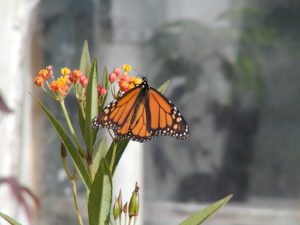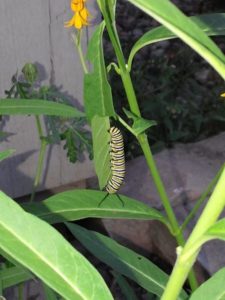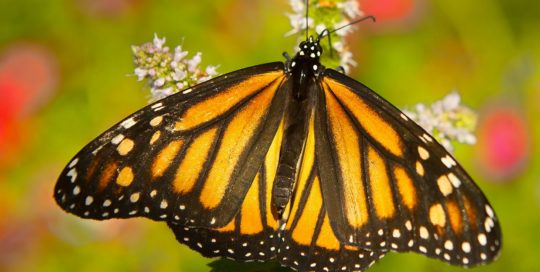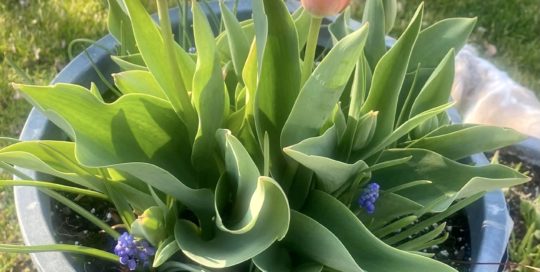Monarchs are the royalty of butterflies. Here in the Midwest, they can be a common sight in summer and fall as they travel through gardens, prairies, roadsides and natural areas. Their large, iridescent orange and black wings are hard to miss. Because of their size, the monarch (Danaus plexippus) is perhaps the most well-known butterfly in North America.
Monarch butterflies are renowned for their long-distance seasonal migration and spectacular winter gatherings in Mexico and California. However, their populations have either declined or greatly fluctuated in the past 20 years. A loss of habitat here and in Mexico and a loss of their host plants—members of the milkweed family—are considered two of the factors. As gardeners, there are many things we can do to help monarchs not only survive, but thrive. I like to start off with providing host plants for the caterpillars and nectar-filled flowers for the butterflies.

Doing the Math
In the 1990s, millions of monarchs made the epic flight each fall from the northern plains of the U.S. and Canada to central Mexico. Besides the largest populations in the group of “Eastern monarchs,” more than a million overwintered in forested groves on the California coast. The butterflies also exist west of the Rockies, through Central America into northern South America, in New Zealand and coastal Australia, some islands north of Australia and in a few parts of Europe where they may have been accidentally introduced.
The Xerces Society reports that researchers and scientists estimate that only a fraction of the monarch’s population remains from decades ago—a decline of approximately 70 percent has been noted in central Mexico and a decline of more than 95 percent in California. However, there was some good news earlier this year. The Western monarch population count showed a winter tally of more than 247,000 monarch butterflies that were observed across the West—an incredible increase from the previous year’s total of less than 2,000 and the highest total since 2016! That is something to celebrate.
Monarchs face other threats from the time the female lays an egg on a leaf to when the adult butterfly emerges from the chrysalis (pupa). The eggs and larvae face threats from other creatures (spiders, beetles and wasps). If there are too many monarch caterpillars on a milkweed plant, some of the larger caterpillars will eat the smaller ones. Let’s take a look at their lifecycle and how you can help them.
Life Cycle
In the first few months of each year, monarchs leave Mexico where they have overwintered and begin migrating north to mate and lay eggs. To fly, they need temperatures of about 55 degrees. After mating, the female looks for milkweed plants to lay eggs, as many as 400 to 500 of them. The female lays one egg at a time on the underside of a milkweed leaf or on or near the flowers. I’ve found eggs and caterpillars on unripe milkweed seed pods.
Researchers have confirmed that female monarchs look for smaller milkweed plants although they will visit the pink flowers of taller common milkweed. They frequently lay multiple eggs on young and re-sprouting milkweeds that were cut down in summer. I’ve observed this in our own garden this year. The females will visit the tall, flowering common milkweeds for nectar but will go to the smaller plants to lay eggs.
The egg is about the size of a grain of salt. Monarchs typically lay eggs on the underside of the leaf, and occasionally on a flower bud or stem as well. The egg has a hard coating and within 3 to 5 days, the caterpillar chews its way out and then consumes the shell.

The Caterpillar
Because the caterpillar’s skin (exoskeleton) does not stretch as it grows, it is shed, a process called molting. An instar is the stage of growth between molts; monarchs have five instars. Each time the caterpillar molts, it rests for a day or so before resuming its munching on the milkweed leaves.
The caterpillar (larval) state lasts from 10 to 14 days. When it reaches its fifth and final instar, the caterpillar wanders off the plant looking for a place to pupate (form a chrysalis). I discovered one monarch chrysalis hanging from an evergreen shrub that was 50 feet away from the nearest milkweed plant. I have found chrysalids suspended from the sides of pots and under our patio chairs.

Transformation
During the next 11 to 15 days, the caterpillar’s body inside the chrysalis dissolves and is transformed into the butterfly. The chrysalis will change from green, becoming more transparent and exposing the dark wings within. It takes just a few minutes for the butterfly to emerge and then several hours before it reaches adult size. This time is important because the butterfly will pump its wings, which fill with hemolymph (blood) to enlarge and stiffen them. In a day or so, the butterfly will be ready to seek flowers for its first nectar meal. By the way, never touch a butterfly that is not ready to take flight. Doing so can damage the wings so that they won’t fully develop and flight will be impossible.

Migration
The monarch’s migration is extraordinary. A butterfly that emerges from a chrysalis in Canada or the northern U.S. in late summer or early fall begins an epic journey. They fly up to 2800 miles to a place they’ve never been before. Monarch butterflies follow their great-great grandparents left earlier in the year. This last annual generation from the northern states does not mate. It must find enough nectar to fuel its long trip south. Once they arrive in Mexico, the monarchs enter diapause, a long winter rest, until early in the year when they mate and head north. Two or three generations follow the first. Each generation of monarch butterflies move further north through the summer. The great fall migration starts in southern Canada about mid-August and the majority of migrants travel through the heart of the eastern and central U.S. in September.
The Caterpillar’s Diet
Milkweed plants are perhaps best known for their role as the larval food plants of the monarch butterfly. During World War II, milkweed seed pod “fluff” was used in life jackets. A monarch will only lay its eggs on native milkweeds (Asclepias spp.). The plants contain chemical toxins (cardenolides) that do not greatly affect the caterpillar or butterfly, but make them unappealing to potential predators. The monarch’s vivid colors are a caution to birds. Any bird that tries to eat a monarch butterfly soon discovers that it is unpalatable.
The Butterfly Border
The sunny borders in our one-acre garden are planted to attract as many butterflies as possible. They are a combination of native perennials, “nativars”—cultivated native plants, and a large assortment of annuals. Some of their favorite flowers include zinnias, coneflowers, sunflowers, asters, helenium, tithonia and rudbeckia (black-eyed Susans). As a child growing up in Chicago, I watched migrating monarch butterflies in September visit the zinnias that my English mother planted in a very narrow border along the fence. I was always amazed that they could find this little strip of color. Few other gardens—or nectar plants—existed in the neighborhood.
Annuals and late-flowering perennials provide nectar for migrating monarchs that are still active in early fall here in Illinois. Asters, salvia, marigolds, sunflowers, boltonia, chrysanthemums, cosmos, lantana, ageratum and helenium and are just a few of the flowers that attract them.
More on Milkweed
There are 73 species of native milkweeds in the United States. Monarchs use about 30 of these species as host plants with some regularity. To find out what milkweed species are found in your region, visit Monarch Watch, a nonprofit educational outreach program at the University of Kansas that focuses on the monarch butterfly, its habitat, and its spectacular fall migration.
Here in Illinois, I look for milkweed plants that are native to the state. They include common milkweed (Asclepias syriaca), butterfly weed (A. tuberosa), swamp milkweed (A. incarnata), prairie milkweed (A. sullivantii) and tall green milkweed (A. hirtella). There are many other milkweeds native to Illinois but it is often difficult to find them at garden centers, so an alternative is ordering the plants or seeds online or visiting a native plant nursery. A word of caution for those who have smaller gardens: common milkweed spreads very quickly in a garden so you may want to look for one that’s clump-forming, such as butterfly weed or swamp milkweed. Use a slow-release plant food to keep it going well into the season.

Build a Butterfly Banquet
Here are some tips for attracting monarchs and other butterflies to your garden:
- Read on. Kylee Baumle has an excellent book on monarch butterflies. Check out “The Monarch: Saving our Most-Loved Butterfly” (St. Lynn’s Press, $20).
- Identify them, Get a good butterfly identification book, such as “Gardening for Butterflies” by the Xerces Society (Timber Press, $24.95), and “The Life Cycle of Butterflies” by Judy Burris and Wayne Richards (Storey Publishing, $16.95).
- Feed ’em. Add nectar-rich annuals, such as zinnias, Mexican sunflower, pentas and lantana, which bloom from spring through fall.
- Plant in large drifts. Butterflies floating overhead can easily spot large groups of flowers. And, they won’t have to fly 20 feet to the next plant to get a sweet drink.
- Simple is better. Include perennials and annuals that have single daisy-type flowers, such as daisies, black-eyed Susans and sunflowers. It’s easier for butterflies to reach the nectar.
- Go native. Add some plants that are native to your region. Native plants support thousands of species of pollinators including native bees, butterflies, moths, flies, wasps, and flower-visiting beetles.
- Create a butterfly nursery. Add host plants. For example, plant some swamp milkweed or butterfly milkweed for monarchs. Eastern black swallowtails will lay eggs on dill, fennel and parsley.
- Be a lazy gardener. Hold off on fall clean up of annuals and perennials. Some butterfly chrysalids (not monarchs) overwinter in the garden and emerge in the spring.
- Be a butterfly bartender. Some butterflies visit mud puddles and damp soil where they glean salts and nutrients not found in nectar. Place a shallow dish of wet sand where butterflies can sip.
- Get involved. Join the North American Butterfly Association. www.naba.org
- Skip the pesticides. Many products are indiscriminate and will kill good and bad caterpillars.











